Who Is Atributed With the Post Impressionism Art Movement

Mail service-Impressionism (also spelled Postimpressionism) was a predominantly French art movement that developed roughly between 1886 and 1905, from the last Impressionist exhibition to the birth of Fauvism. Post-Impressionism emerged every bit a reaction against Impressionists' concern for the naturalistic depiction of light and colour. Its broad accent on abstract qualities or symbolic content ways Post-Impressionism encompasses Les Nabis, Neo-Impressionism, Symbolism, Cloisonnism, Pont-Aven School, too as Synthetism, along with some later Impressionists' work. The movements principal artists were Paul Cézanne (known as the father of Post-Impressionism), Paul Gauguin, Vincent van Gogh and Georges Seurat.[1]
The term Post-Impressionism was start used by art critic Roger Fry in 1906.[2] [3] Critic Frank Rutter in a review of the Salon d'Automne published in Art News, fifteen October 1910, described Othon Friesz as a "postal service-impressionist leader"; there was also an advert for the show The Post-Impressionists of France.[4] Three weeks later, Roger Fry used the term again when he organised the 1910 exhibition Manet and the Post-Impressionists, defining it every bit the evolution of French fine art since Manet.
Post-Impressionists extended Impressionism while rejecting its limitations: they continued using vivid colours, sometimes using impasto (thick application of paint) and painting from life, but were more than inclined to emphasize geometric forms, misconstrue form for expressive effect, and a sometimes unnatural or modified colour.
Overview [edit]
The Postal service-Impressionists were dissatisfied with what they felt was the triviality of subject thing and the loss of structure in Impressionist paintings, though they did not agree on the way forward. Georges Seurat and his followers concerned themselves with pointillism, the systematic use of tiny dots of colour. Paul Cézanne set out to restore a sense of order and structure to painting, to "make of Impressionism something solid and durable, similar the art of the museums".[five] He achieved this past reducing objects to their basic shapes while retaining the saturated colours of Impressionism. The Impressionist Camille Pissarro experimented with Neo-Impressionist ideas betwixt the mid-1880s and the early 1890s. Discontented with what he referred to as romantic Impressionism, he investigated pointillism, which he called scientific Impressionism, before returning to a purer Impressionism in the last decade of his life.[6] Vincent van Gogh frequently used vibrant color and conspicuous brushstrokes to convey his feelings and his state of mind.
Although they oft exhibited together, Mail service-Impressionist artists were not in agreement apropos a cohesive movement. Yet, the abstract concerns of harmony and structural arrangement, in the work of all these artists, took precedence over naturalism. Artists such every bit Seurat adopted a meticulously scientific approach to colour and composition.[vii]
Defining Post-Impressionism [edit]
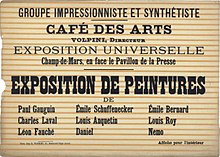

The term was used in 1906,[2] [three] and once more in 1910 by Roger Fry in the championship of an exhibition of mod French painters: Manet and the Post-Impressionists, organized by Fry for the Grafton Galleries in London.[7] [viii] 3 weeks before Fry'due south show, art critic Frank Rutter had put the term Mail service-Impressionist in print in Fine art News of 15 October 1910, during a review of the Salon d'Automne, where he described Othon Friesz equally a "post-impressionist leader"; there was also an ad in the journal for the show The Post-Impressionists of France.[4]
Most of the artists in Fry'due south exhibition were younger than the Impressionists. Fry later explained: "For purposes of convenience, it was necessary to give these artists a name, and I chose, as being the vaguest and nearly non-committal, the name of Post-Impressionism. This merely stated their position in time relatively to the Impressionist motility."[nine] John Rewald limited the scope to the years between 1886 and 1892 in his pioneering publication on Post-Impressionism: From Van Gogh to Gauguin (1956). Rewald considered this a continuation of his 1946 study, History of Impressionism, and pointed out that a "subsequent volume dedicated to the second half of the mail-impressionist period":[ten] Post-Impressionism: From Gauguin to Matisse, was to follow. This volume would extend the period covered to other creative movements derived from Impressionism, though confined to the belatedly 19th and early 20th centuries. Rewald focused on such outstanding early on Post-Impressionists active in French republic as van Gogh, Gauguin, Seurat, and Redon. He explored their relationships as well as the artistic circles they frequented (or were in opposition to), including:
- Neo-Impressionism: ridiculed by contemporary fine art critics as well as artists as Pointillism; Seurat and Signac would have preferred other terms: Divisionism for example
- Cloisonnism: a short-lived term introduced in 1888 by the art critic Édouard Dujardin, was to promote the work of Louis Anquetin, and was later besides applied to gimmicky works of his friend Émile Bernard
- Synthetism: another short-lived term coined in 1889 to distinguish recent works of Gauguin and Bernard from that of more traditional Impressionists exhibiting with them at the Café Volpini.
- Pont-Aven Schoolhouse: implying piddling more than than that the artists involved had been working for a while in Pont-Aven or elsewhere in Brittany.
- Symbolism: a term highly welcomed by vanguard critics in 1891, when Gauguin dropped Synthetism equally soon every bit he was acclaimed to be the leader of Symbolism in painting.
Furthermore, in his introduction to Post-Impressionism, Rewald opted for a 2d volume featuring Toulouse-Lautrec, Henri Rousseau "le Douanier", Les Nabis and Cézanne besides as the Fauves, the immature Picasso and Gauguin'due south concluding trip to the Southward Seas; information technology was to aggrandize the catamenia covered at least into the starting time decade of the 20th century—yet this second volume remained unfinished.

Reviews and adjustments [edit]
Rewald wrote that "the term 'Post-Impressionism' is not a very precise one, though a very convenient one." User-friendly, when the term is by definition limited to French visual arts derived from Impressionism since 1886. Rewald's approach to historical data was narrative rather than analytic, and beyond this point he believed information technology would be sufficient to "let the sources speak for themselves."[10]
Rival terms like Modernism or Symbolism were never equally easy to handle, for they covered literature, compages and other arts as well, and they expanded to other countries.
- Modernism, thus, is at present considered to be the cardinal movement within international western culture with its original roots in France, going back beyond the French Revolution to the Age of Enlightenment.
- Symbolism, however, is considered to be a concept which emerged a century later in France, and implied an individual approach. Local national traditions as well equally private settings therefore could stand up side past side, and from the very beginning a broad variety of artists practicing some kind of symbolic imagery, ranged betwixt extreme positions: The Nabis for instance united to find synthesis of tradition and brand new form, while others kept to traditional, more or less academic forms, when they were looking for fresh contents: Symbolism is therefore often linked to fantastic, esoteric, erotic and other non-realist discipline matter.
To run across the contempo give-and-take, the connotations of the term 'Mail-Impressionism' were challenged again: Alan Bowness and his collaborators expanded the period covered frontwards to 1914 and the beginning of World State of war I, but limited their approach widely on the 1890s to France. Other European countries are pushed back to standard connotations, and Eastern Europe is completely excluded.
And then, while a split may be seen between classical 'Impressionism' and 'Postal service-Impressionism' in 1886, the end and the extent of 'Mail service-Impressionism' remains nether discussion. For Bowness and his contributors likewise as for Rewald, 'Cubism' was an absolutely fresh beginning, and so Cubism has been seen in France since the offset, and later in England. Meanwhile, Eastern European artists, however, did not care so much for western traditions, and proceeded to manners of painting chosen abstruse and suprematic—terms expanding far into the 20th century.
According to the nowadays state of discussion, Post-Impressionism is a term best used within Rewald's definition in a strictly historical manner, concentrating on French art betwixt 1886 and 1914, and re-considering the altered positions of impressionist painters like Claude Monet, Camille Pissarro, Auguste Renoir, and others—too as all new schools and movements at the turn of the century: from Cloisonnism to Cubism. The declarations of state of war, in July/August 1914, bespeak probably far more than the beginning of a World War—they signal a major pause in European cultural history, too.
Along with general art history information given about "Post-Impressionism" works, there are many museums that offering additional history, information and gallery works, both online and in house, that can assist viewers understand a deeper significant of "Post-Impressionism" in terms of fine art and traditional fine art applications.
Mail-Impression in specific countries [edit]
The Advent of Modernism: Post-impressionism and Due north American Art, 1900-1918 by Peter Morrin, Judith Zilczer, and William C. Agee, the catalogue for an exhibition at the High Museum of Fine art, Atlanta in 1986, gave a major overview of Post-Impressionism in N America.
Canada [edit]
Canadian Post-Impressionism is an adjunct of Postal service-Impressionism.[11] In 1913, the Art Clan of Montreal'due south Spring bear witness included the piece of work of Randolph Hewton, A. Y. Jackson and John Lyman: information technology was reviewed with sharp criticism past the Montreal Daily Witness and the Montreal Daily Star.[12] Post-Impressionism was extended to include a painting by Lyman, who had studied with Matisse.[thirteen] [xiv] Lyman wrote in defense of the term and defined information technology. He referred to the British show which he described as a bang-up exhibition of modern art.[eleven]
Canadian artists and exhibitions [edit]
A wide and diverse variety of artists are called past this name in Canada, amidst them are James Wilson Morrice,[fifteen] John Lyman,[16] David Milne,[17] and Tom Thomson,[xviii] members of the Group of Seven,[19] and Emily Carr.[20] In 2001, the Robert McLaughlin Gallery in Oshawa organized the traveling exhibition The Birth of the Modern: Postal service-Impressionism in Canada, 1900-1920.
Gallery of major Post-Impressionist artists [edit]
See as well [edit]
- Art periods
- Cubism
- Kapists
- Neo-impressionism
- Expressionism
References and sources [edit]
- References
- ^ Metropolitan Museum of Art Timeline, Post-Impressionism
- ^ a b Brettell, Richard R.; Brettell, Richard (March 31, 1999). Modern Art, 1851-1929: Capitalism and Representation. Oxford University Press. ISBN9780192842206 – via Google Books.
- ^ a b Peter Morrin, Judith Zilczer, William C. Agee, The Advent of Modernism. Post-Impressionism and N American Fine art, 1900-1918, High Museum of Art, 1986
- ^ a b Bullen, J. B. Post-impressionists in England, p.37. Routledge, 1988. ISBN 0-415-00216-8, ISBN 978-0-415-00216-5
- ^ Huyghe, Rene: Impressionism. (1973). Secaucus, N.J.: Chartwell Books Inc., p. 222. OCLC 153804642
- ^ Cogniat, Raymond (1975). Pissarro. New York: Crown, pp. 69–72. ISBN 0-517-52477-v.
- ^ a b "The Collection | MoMA". The Museum of Modernistic Fine art.
- ^ Grafton Galleries, London (March 31, 1910). "Manet and the mail-impressionists; Nov. eighth to Jan. 15th, 1910-11... (under revision)". London : Ballantyne – via Internet Annal.
- ^ Gowing, Lawrence (2005). Facts on File Encyclopedia of Art: 5. New York: Facts on File, p. 804. ISBN 0-8160-5802-4
- ^ a b Rewald, John: Post-Impressionism: From Van Gogh to Gauguin, revised edition: Secker & Warburg, London, 1978, p. 9.
- ^ a b Murray 2001, p. 16. sfn error: no target: CITEREFMurray2001 (aid)
- ^ Murray 2001, pp. 15–16. sfn error: no target: CITEREFMurray2001 (help)
- ^ Lyman, John. "Adieux, Matisse". Canadian Art. 12 (two (Winter 1955)): 44–46. Retrieved 2021-01-29 .
- ^ Murray 2001, p. 143-144. sfn error: no target: CITEREFMurray2001 (help)
- ^ Murray 2001, p. 117ff. sfn error: no target: CITEREFMurray2001 (assistance)
- ^ Murray 2001, pp. 83–84, 143–144. sfn fault: no target: CITEREFMurray2001 (help)
- ^ Murray 2001, p. 111ff. sfn error: no target: CITEREFMurray2001 (aid)
- ^ Murray 2001, p. 133ff. sfn error: no target: CITEREFMurray2001 (aid)
- ^ Murray 2001, p. 61ff, 78ff,81ff etc.. sfn error: no target: CITEREFMurray2001 (help)
- ^ Murray 2001, p. 50ff. sfn error: no target: CITEREFMurray2001 (assist)
- Sources
- Bowness, Alan, et alt.: Mail-Impressionism. Cross-Currents in European Painting, Royal University of Arts & Weidenfeld and Nicolson, London 1979 ISBN 0-297-77713-0
Further reading [edit]
- Manet and the Post-Impressionists (exh. cat. past R. Fry and D. MacCarthy, London, Grafton Gals, 1910–eleven)
- The 2d Post-Impressionist Exhibition (exh. true cat. by R. Fry, London, Grafton Gals, 1912)
- J. Rewald. Post-Impressionism: From Van Gogh to Gauguin (New York, 1956, rev. three/1978)
- F. Elgar. The Post-Impressionists (Oxford, 1977)
- Mail service-Impressionism: Cross-currents in European Painting (exh. cat., ed. J. House and M. A. Stevens; London, RA, 1979–lxxx)
- B. Thomson. The Post-Impressionists (Oxford and New York, 1983, rev. ii/1990)
- J. Rewald. Studies in Postal service-Impressionism (London, 1986)
- Across Impressionism, exhibit at Columbus Museum of Fine art, Oct 21, 2017 – January 21, 2018 Across Impressionism Exhibition at Columbus Museum of Art
External links [edit]
- "Post-Impressionists", Walter Sickert's review in The Fortnightly Review of the "Manet and the Post-Impressionists" exhibition at the Grafton Galleries
- "Post-Impressionism", Roger Fry's lecture on the closing of the "Manet and the Mail service-Impressionists" exhibition at the Grafton Galleries, every bit published in The Fortnightly Review
- Georges Seurat, 1859-1891, a total text exhibition catalog from The Metropolitan Museum of Art
- Toulouse-Lautrec in the Metropolitan Museum of Art, a total text exhibition catalog from The Metropolitan Museum of Art
- "Roger Fry, Walter Sickert and Post-Impressionism at the Grafton Galleries", a reflection past Prof. Marnin Young on the 1910-1911 exhibition
borregowhatumbigh.blogspot.com
Source: https://en.wikipedia.org/wiki/Post-Impressionism







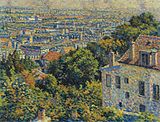



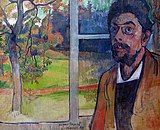


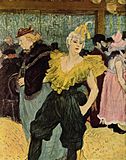


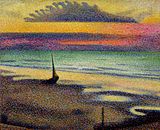


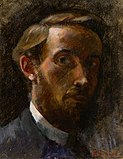


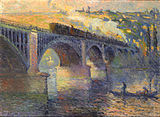
0 Response to "Who Is Atributed With the Post Impressionism Art Movement"
Post a Comment